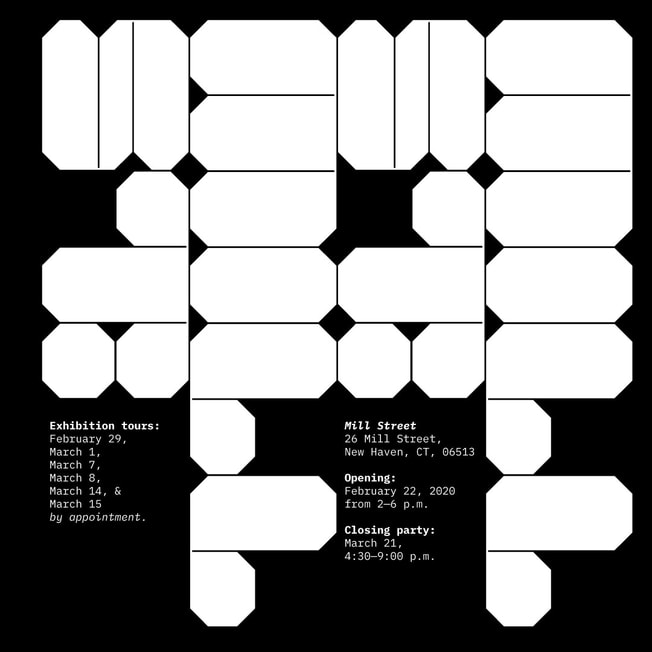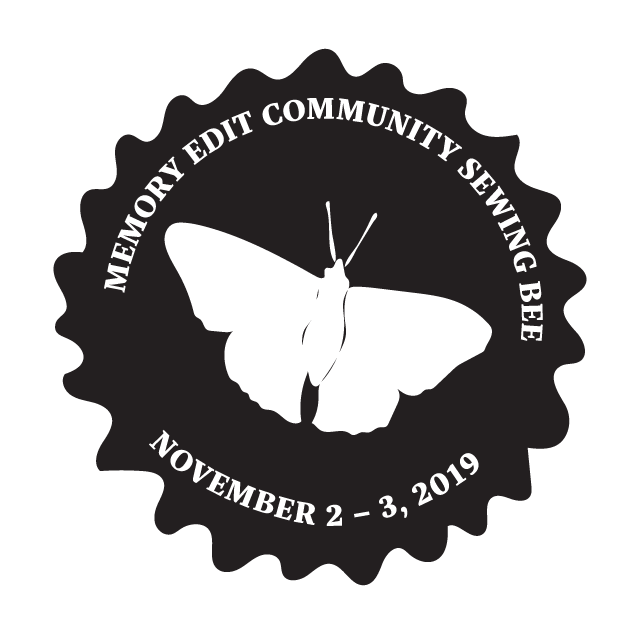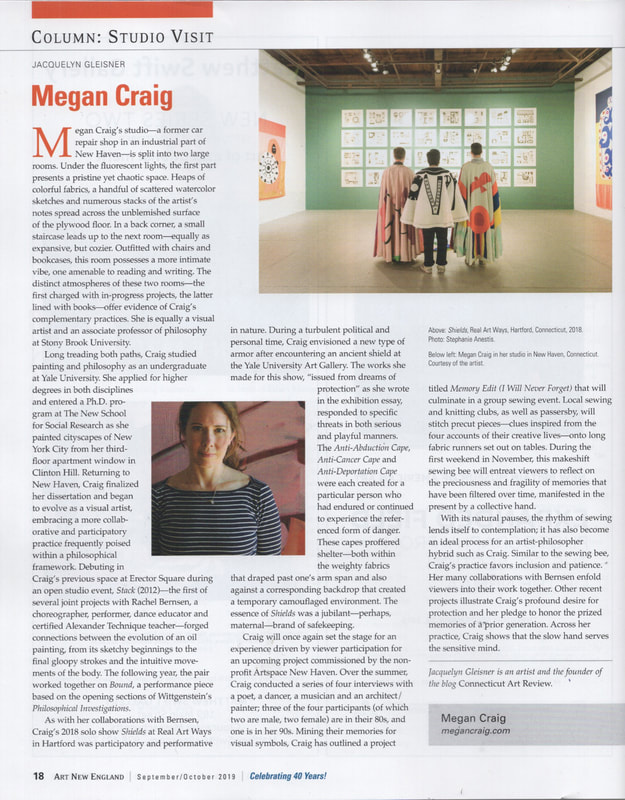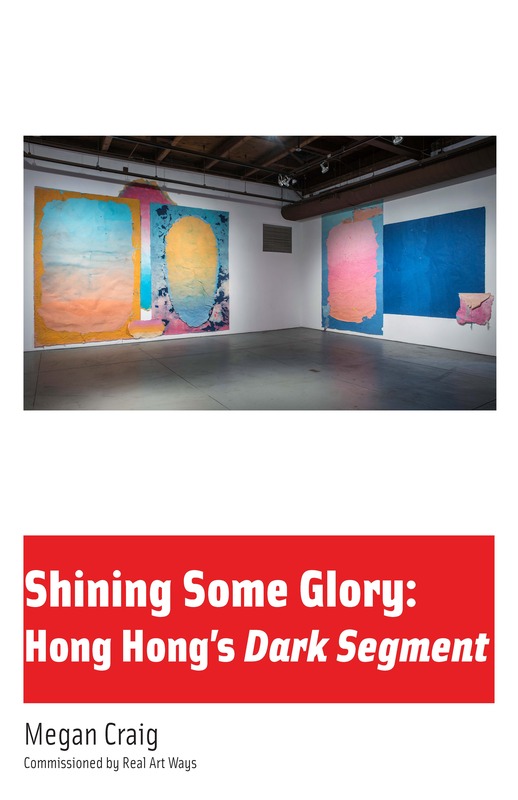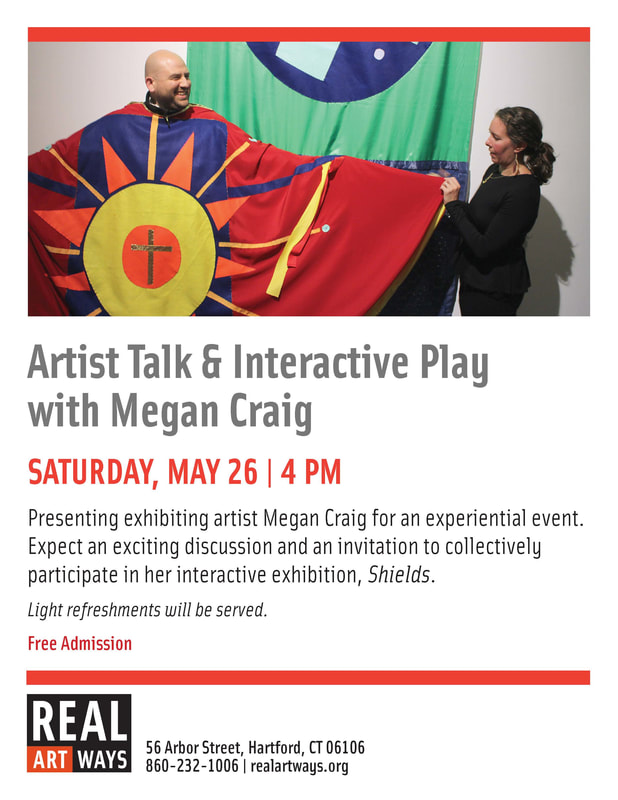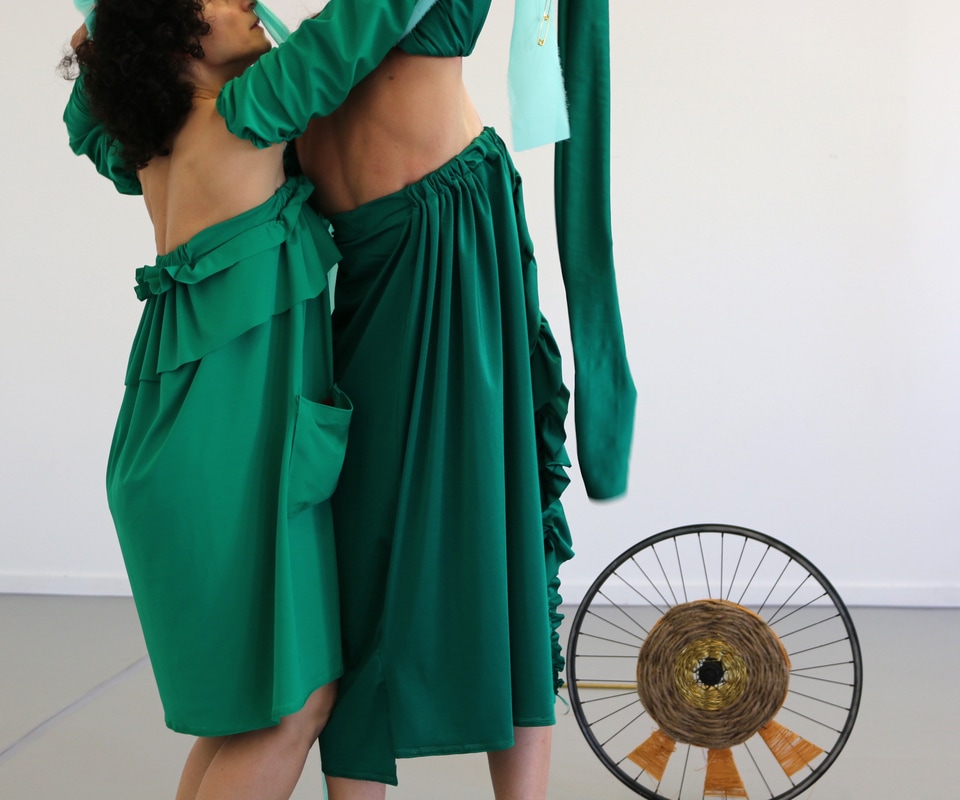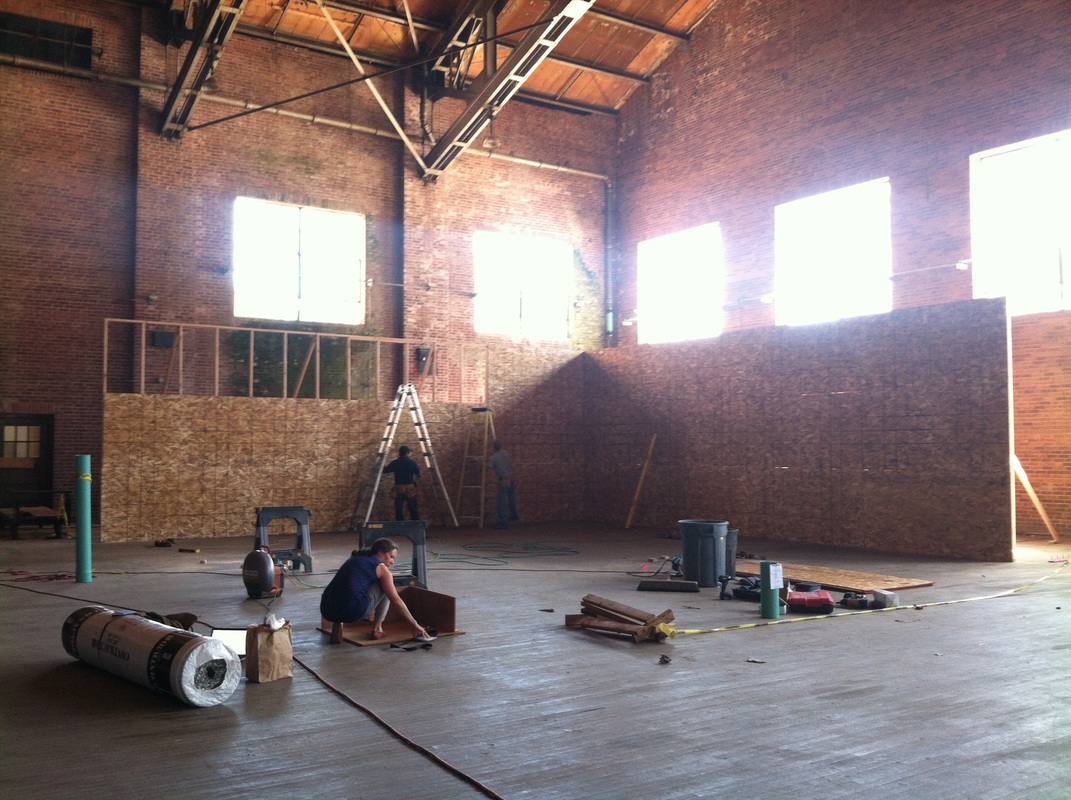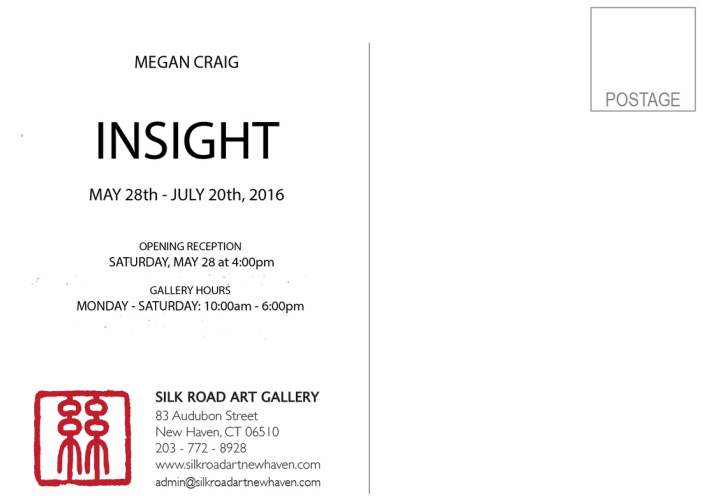Philosophy and Film Podcast: Power of the Dog
April, 2022
Guest Commentator for a Philosophy and Film episode about The Power of the Dog.
April, 2022
Guest Commentator for a Philosophy and Film episode about The Power of the Dog.
Connecticut Art Review Quarantine Reading List
April 29, 2020
A short list of 3 texts to read during quarantine, along with images of past works.
April 29, 2020
A short list of 3 texts to read during quarantine, along with images of past works.
Mill Street
Group exhibition opening February 22, 2020, from 2 - 6 PM
26 Mill Street, New Haven CT.
Group exhibition opening February 22, 2020, from 2 - 6 PM
26 Mill Street, New Haven CT.
Gorky's Granddaughter Interview, February 2020
Click here to find a new video interview about the last seven years of my work on Gorky's Granddaughter. There is also an updated and expanded version of an interview I did in 2013 posted on the same site.
Click here to find a new video interview about the last seven years of my work on Gorky's Granddaughter. There is also an updated and expanded version of an interview I did in 2013 posted on the same site.
Memory Edit (I will never forget...)
November 2 - 3, 2019, 12 - 6 PM
Yale West Campus, 410 West Campus Drive, New Haven CT
a commissioned project for New Haven Citywide Open Studios.
Memory Edit (I will never forget...) is a collaborative project that explores the phenomenon of memory through touch, sound, and movement. Commissioned by Artspace for the 2019 New Haven Citywide Open Studios, the works consists of four fabric banners arranged with graphics and texts in hand-cut felt. Each banner represents memories from one of four artists in their 80s and 90s. On November 2 - 3, I am inviting sewing groups and individuals to help hand stitch the felt onto the banners in a collective performance and sewing bee. Please click here to sign up for a sewing time. All ages and abilities welcome, no prior experience necessary. Participants may sign up in advance or drop in.
Read about the 2019 commissioned projects in the New Haven Independent here.
November 2 - 3, 2019, 12 - 6 PM
Yale West Campus, 410 West Campus Drive, New Haven CT
a commissioned project for New Haven Citywide Open Studios.
Memory Edit (I will never forget...) is a collaborative project that explores the phenomenon of memory through touch, sound, and movement. Commissioned by Artspace for the 2019 New Haven Citywide Open Studios, the works consists of four fabric banners arranged with graphics and texts in hand-cut felt. Each banner represents memories from one of four artists in their 80s and 90s. On November 2 - 3, I am inviting sewing groups and individuals to help hand stitch the felt onto the banners in a collective performance and sewing bee. Please click here to sign up for a sewing time. All ages and abilities welcome, no prior experience necessary. Participants may sign up in advance or drop in.
Read about the 2019 commissioned projects in the New Haven Independent here.
Studio Visit by Jacquelyn Gleisner in the September/October issue of Art New England.
Suspended Moods, stainless steel cable, bamboo, paint, varnish
September 2019
A site-specific, participatory installation work about emotional intelligence made in conjunction with the Foote School in New Haven, CT. Work begins in August of 2019 and continues throughout the fall. Photographs by Stephanie Anestis.
September 2019
A site-specific, participatory installation work about emotional intelligence made in conjunction with the Foote School in New Haven, CT. Work begins in August of 2019 and continues throughout the fall. Photographs by Stephanie Anestis.
Megan Craig performing Piña Bausch's NELKEN-line with philosophers at Collegium Phaenomenologicum in Italy.
July, 2019
Click here for video of the performance.
July, 2019
Click here for video of the performance.
Artist/Mother Podcast
Episode 18, May 20, 2019
Click here to hear an interview conducted by Artist/Mother creator and fellow painter Kaylan Buteyn.
Episode 18, May 20, 2019
Click here to hear an interview conducted by Artist/Mother creator and fellow painter Kaylan Buteyn.
Connecticut Art Review Studio Visit
February 3, 2019
Click here to read the text of Connnecticut Art Review's recent studio visit with me.
February 3, 2019
Click here to read the text of Connnecticut Art Review's recent studio visit with me.
Megan Craig & Hong Hong in Conversation
February 10th, 2019, 2:30 PM
Real Art Ways
56 Arbor Street
Hartford, CT 06106
Join artists Hong Hong and Megan Craig for a conversation surrounding the exhibition Dark Segment and Craig’s essay commissioned by Real Art Ways. The reception will open at 2:30 PM, with conversation beginning at 3:00 PM. Admission is free, with light refreshments available.
While at Real Art Ways, Visual Arts Coordinator Neil Daigle Orians has worked with both artists in producing solo exhibitions. Commenting on their work, he said, “Hong Hong met Megan Craig at the opening for her 2018 Real Art Ways exhibit Shields. Their connection serves as a beautiful metaphor for how Real Art Ways supports and connects artists, creating community along the way. Craig’s essay is a fantastic exploration in the concepts and impacts Hong’s massive paperworks create. I am excited to hear their conversation and join in.”
Click here to learn more about Dark Segment.
Visit Real Art Ways to pick up a copy of Craig’s essay, Shining Some Glory: Hong Hong’s Dark Segment.
Dark Segment was supported by the Edward C. & Ann T. Roberts Foundation’s Creation of New Works Initiative.
February 10th, 2019, 2:30 PM
Real Art Ways
56 Arbor Street
Hartford, CT 06106
Join artists Hong Hong and Megan Craig for a conversation surrounding the exhibition Dark Segment and Craig’s essay commissioned by Real Art Ways. The reception will open at 2:30 PM, with conversation beginning at 3:00 PM. Admission is free, with light refreshments available.
While at Real Art Ways, Visual Arts Coordinator Neil Daigle Orians has worked with both artists in producing solo exhibitions. Commenting on their work, he said, “Hong Hong met Megan Craig at the opening for her 2018 Real Art Ways exhibit Shields. Their connection serves as a beautiful metaphor for how Real Art Ways supports and connects artists, creating community along the way. Craig’s essay is a fantastic exploration in the concepts and impacts Hong’s massive paperworks create. I am excited to hear their conversation and join in.”
Click here to learn more about Dark Segment.
Visit Real Art Ways to pick up a copy of Craig’s essay, Shining Some Glory: Hong Hong’s Dark Segment.
Dark Segment was supported by the Edward C. & Ann T. Roberts Foundation’s Creation of New Works Initiative.
#Unload: Pick up the Pieces
October 11 - November 11, 2018
Ely Center of Contemporary Art
51 Trumbull Street, New Haven CT 06510
www.elycenter.org
October 11 - November 11, 2018
Ely Center of Contemporary Art
51 Trumbull Street, New Haven CT 06510
www.elycenter.org
Shields
April 19th - June 10th, 2018
Opening reception Thursday April 19, 6 - 8 PM / Artist Talk in the gallery Saturday May 26, 4 PM
Real Art Ways
56 Arbor Street
Hartford, CT
April 19th - June 10th, 2018
Opening reception Thursday April 19, 6 - 8 PM / Artist Talk in the gallery Saturday May 26, 4 PM
Real Art Ways
56 Arbor Street
Hartford, CT
| shieldsessay2018.pdf | |
| File Size: | 95 kb |
| File Type: | |
| megancraig_release.pdf | |
| File Size: | 256 kb |
| File Type: | |
Click here for the Hartford Courant article about Shields.
Traveling in Place
May 18th, 2017 at 5:30 and 6:15 PM, June 13th at 4 PM
The Yale University Art Gallery
1111 Chapel Street, New Haven, CT
Fabric, wheels, string, thread, safety pins, sound
Variable Dimensions
Traveling in Place is an improvisational performance and installation work created and performed by Megan Craig and Rachel Bernsen for the Yale Art Gallery in 2017 in conjunction with the exhibit Small-Great Objects: Anni and Josef Albers in the Americas. Based on ideas about localized customs and micro-movements, weaving, fabric as architecture, and communicative patterns, Traveling in Place involves chance rotations and interactions between Bernsen and Craig as they move in and between three demarcated floor spaces, each with its own set of material and dynamic characteristics. The performance entails entanglement and experimentation with thread, wheels, fabric, and wearable sculpture. A 30-minute sound score created by Nick Lloyd and Megan Craig accompanies the work.
May 18th, 2017 at 5:30 and 6:15 PM, June 13th at 4 PM
The Yale University Art Gallery
1111 Chapel Street, New Haven, CT
Fabric, wheels, string, thread, safety pins, sound
Variable Dimensions
Traveling in Place is an improvisational performance and installation work created and performed by Megan Craig and Rachel Bernsen for the Yale Art Gallery in 2017 in conjunction with the exhibit Small-Great Objects: Anni and Josef Albers in the Americas. Based on ideas about localized customs and micro-movements, weaving, fabric as architecture, and communicative patterns, Traveling in Place involves chance rotations and interactions between Bernsen and Craig as they move in and between three demarcated floor spaces, each with its own set of material and dynamic characteristics. The performance entails entanglement and experimentation with thread, wheels, fabric, and wearable sculpture. A 30-minute sound score created by Nick Lloyd and Megan Craig accompanies the work.
The Way Things Felt
October 15th - 16th, 2016
12 - 6 PM
The Drill Hall at the Goffe Street Armory
290 Goffe Street
New Haven, CT 06511
The Way Things Felt is an immersive environment and collaborative artwork you are welcome to inhabit, observe, and co-create as a part of New Haven CityWide Open Studios. The work, which entails following simple rules for pressing large abstract felt shapes onto fabric-covered walls and floor, is suitable for all ages and abilities. The Way Things Felt is funded in part by generous support from Artspace and The National Endowment for the Arts.
Special Autism-friendly performance and participation on Monday, October 17th from 3 - 5 PM. Please contact me for details.
October 15th - 16th, 2016
12 - 6 PM
The Drill Hall at the Goffe Street Armory
290 Goffe Street
New Haven, CT 06511
The Way Things Felt is an immersive environment and collaborative artwork you are welcome to inhabit, observe, and co-create as a part of New Haven CityWide Open Studios. The work, which entails following simple rules for pressing large abstract felt shapes onto fabric-covered walls and floor, is suitable for all ages and abilities. The Way Things Felt is funded in part by generous support from Artspace and The National Endowment for the Arts.
Special Autism-friendly performance and participation on Monday, October 17th from 3 - 5 PM. Please contact me for details.
Insight
May 28 - July 20, 2016
Silk Road Art Gallery
83 Audubon Street, New Haven, Ct 06510
Opening Reception on Saturday, May 28th at 4 PM.
Gallery discussion and closing party on Monday, July 18th, 6 - 8 PM.
Reviewed by David Sepulveda for The New Haven Independent.
Public Discussion with Steven Digiovanni on Vimeo.
May 28 - July 20, 2016
Silk Road Art Gallery
83 Audubon Street, New Haven, Ct 06510
Opening Reception on Saturday, May 28th at 4 PM.
Gallery discussion and closing party on Monday, July 18th, 6 - 8 PM.
Reviewed by David Sepulveda for The New Haven Independent.
Public Discussion with Steven Digiovanni on Vimeo.
Colorada
A new work by Rachel Bernsen and Megan Craig
Music and sound collage by Nick Lloyd, voice by Cora Lloyd and Maria Winther
7pm
Friday November 13, 2015
Tickets $10. Available at the door - cash only
Space is limited
Reservations can be made by email: thebigroomnewhaven@gmail.com
The BIG ROOM | Erector Square | 319 Peck St New Haven, CT 06513
Colorada is the fourth in a series of collaborations between choreographer Rachel Bernsen and visual artist Megan Craig. Evolving from a series of conversations about color, ambiguity, and emotion, Colorada is a performance and installation piece featuring both artists that employs movement, assemblage, and collage. The work premiered May 31, 2015 at Kunstverein Grafschaft Bentheim, in Neuenhaus, Germany.
A talk-back with the artists will immediately follow the performance.
Rose Sings
May 31 - July 26, 2015
Opening on May 31st, with a performance of Colorada (together with Rachel Bernsen).
Kunstverein Grafschaft Bentheim
Hauptstrasse 37
D - 49828 Neuenhaus
Tel. +49(0)59 41-98019
Fax +49(0)59 41-98065
kunstverein.neuenhaus@t-online.de
http://www.kunstvereine.de
May 31 - July 26, 2015
Opening on May 31st, with a performance of Colorada (together with Rachel Bernsen).
Kunstverein Grafschaft Bentheim
Hauptstrasse 37
D - 49828 Neuenhaus
Tel. +49(0)59 41-98019
Fax +49(0)59 41-98065
kunstverein.neuenhaus@t-online.de
http://www.kunstvereine.de
Rose Sings
The work in this show evolved from a series of drawings, experiments, collaborations, reading, and research over the last several years. It is hard to pinpoint when the images emerged. I was making “automatic” paintings in the year leading up to the show, paintings that were intentionally open and fluid, made in acrylic and gouache on paper. I would paint five or six of them in a row, letting them fall to the ground or be pushed aside as the momentum of one gave way to the next. Some days they would accumulate on my floor in piles to be discarded or painted over. Other days, one or two would emerge as strangely self-sufficient – a new shape or emotion on the page. I affixed those to my wall with blue painter’s tape. Over months they accumulated into a grid, showing weird family resemblances.
The works on paper opened onto the first paintings for the show, pictures that included broad areas of color and sinuous, pipe-like assemblages. Neither buildings nor places, they seem to me like processes of congealment, the taking shape of some marginal, fleeting apparatus – a bit of an ear canal, scaffolding, a blurry stack of pinks.
In the meantime, I began reading a text by Gertrude Stein that has come to inform much of my thinking about this show. The World is Round is a book Stein wrote for children in the 1930’s with illustrations by Clement Hurd. Stein envisioned the book printed on pink paper, with prose and Hurd’s drawings overprinted in blue ink. She tells the story of a nine year old girl named Rose who has blue eyes, a cousin named Willie, two dogs, and a favorite blue chair. Willie has a habit of getting into trouble and winds up with a lion he doesn’t want to keep. Rose has a habit of breaking into song and crying each time she sings. She decides to climb a mountain carrying her blue chair with her in order to sit at the top. The climb is harder than she expected, the chair heavier, and the top of the mountain (which she arrives at in the middle of the night) is lonelier and scarier than she imagined it would be. Sitting in her blue chair, singing and crying, she sees a flashing light in the dark, the sweeping beam of a distant lighthouse. She hopes it’s Willie searching for her.
Such a strange little book all in pink, sad and sweet and full of the anguishes of childhood. It also seems related to the anxieties and absurdities of being an artist, forever climbing to the top of a mountain dragging a chair. I was thinking about Rose, and about the color rose, the way it radiates, warms and overtakes things. I was also thinking about Stein’s prose: the repetitive, percussive insistence of her writing that makes you feel the materiality of words as if touching their fleshy centers. There is something terribly vulnerable and at the same time sturdy about her writing – very much like the vulnerability and sturdiness of a child. It’s this mixture of the two extremes that interests me. Things can be coming undone and at the same time holding together. Sometimes the things that appear the least substantial have the greatest resiliency. Sometimes the bravado of things gives way to a core insecurity, and the tough one winds up in a puddle. I think these paintings reflect those transitions between standing up and falling down – the moments when it’s not yet clear whether something is coming together or falling apart, whether something is brave or scared, tough or tender, contained or scattered. Stein shows the poignant absurdity of childhood. There’s something equally funny and poignant in paintings that can be (in one breath) assertive (taking up all the room in the world) and painfully shy (trying to retreat or utterly disappear). Painting happens somewhere between heroic affirmation and embarrassed, blushing, diminutiveness.
Another important aspect of Stein’s story is Rose’s incessant singing. I often wonder about the acoustic dimensions of color and synesthetic experience. I wonder what would it be like to not only see but to hear the paintings, to hear them singing or crying (or babbling, chatting, making bets, telling jokes, howling, giggling, sighing, sneezing, pontificating, swearing, swooning, whistling, snoring, drowning…). What does the color rose sound like? Is Rose singing or crying? How could we tell, and when does one become the other? I prefer the moment just prior to articulation. The mouth is open and poised to vocalize. It could be a song or a wail.
Megan Craig
New Haven, 2015
Reviews of "Rose Sings":
"Rose Sings“ : Megan Craig stellt in Neuenhaus aus
The work in this show evolved from a series of drawings, experiments, collaborations, reading, and research over the last several years. It is hard to pinpoint when the images emerged. I was making “automatic” paintings in the year leading up to the show, paintings that were intentionally open and fluid, made in acrylic and gouache on paper. I would paint five or six of them in a row, letting them fall to the ground or be pushed aside as the momentum of one gave way to the next. Some days they would accumulate on my floor in piles to be discarded or painted over. Other days, one or two would emerge as strangely self-sufficient – a new shape or emotion on the page. I affixed those to my wall with blue painter’s tape. Over months they accumulated into a grid, showing weird family resemblances.
The works on paper opened onto the first paintings for the show, pictures that included broad areas of color and sinuous, pipe-like assemblages. Neither buildings nor places, they seem to me like processes of congealment, the taking shape of some marginal, fleeting apparatus – a bit of an ear canal, scaffolding, a blurry stack of pinks.
In the meantime, I began reading a text by Gertrude Stein that has come to inform much of my thinking about this show. The World is Round is a book Stein wrote for children in the 1930’s with illustrations by Clement Hurd. Stein envisioned the book printed on pink paper, with prose and Hurd’s drawings overprinted in blue ink. She tells the story of a nine year old girl named Rose who has blue eyes, a cousin named Willie, two dogs, and a favorite blue chair. Willie has a habit of getting into trouble and winds up with a lion he doesn’t want to keep. Rose has a habit of breaking into song and crying each time she sings. She decides to climb a mountain carrying her blue chair with her in order to sit at the top. The climb is harder than she expected, the chair heavier, and the top of the mountain (which she arrives at in the middle of the night) is lonelier and scarier than she imagined it would be. Sitting in her blue chair, singing and crying, she sees a flashing light in the dark, the sweeping beam of a distant lighthouse. She hopes it’s Willie searching for her.
Such a strange little book all in pink, sad and sweet and full of the anguishes of childhood. It also seems related to the anxieties and absurdities of being an artist, forever climbing to the top of a mountain dragging a chair. I was thinking about Rose, and about the color rose, the way it radiates, warms and overtakes things. I was also thinking about Stein’s prose: the repetitive, percussive insistence of her writing that makes you feel the materiality of words as if touching their fleshy centers. There is something terribly vulnerable and at the same time sturdy about her writing – very much like the vulnerability and sturdiness of a child. It’s this mixture of the two extremes that interests me. Things can be coming undone and at the same time holding together. Sometimes the things that appear the least substantial have the greatest resiliency. Sometimes the bravado of things gives way to a core insecurity, and the tough one winds up in a puddle. I think these paintings reflect those transitions between standing up and falling down – the moments when it’s not yet clear whether something is coming together or falling apart, whether something is brave or scared, tough or tender, contained or scattered. Stein shows the poignant absurdity of childhood. There’s something equally funny and poignant in paintings that can be (in one breath) assertive (taking up all the room in the world) and painfully shy (trying to retreat or utterly disappear). Painting happens somewhere between heroic affirmation and embarrassed, blushing, diminutiveness.
Another important aspect of Stein’s story is Rose’s incessant singing. I often wonder about the acoustic dimensions of color and synesthetic experience. I wonder what would it be like to not only see but to hear the paintings, to hear them singing or crying (or babbling, chatting, making bets, telling jokes, howling, giggling, sighing, sneezing, pontificating, swearing, swooning, whistling, snoring, drowning…). What does the color rose sound like? Is Rose singing or crying? How could we tell, and when does one become the other? I prefer the moment just prior to articulation. The mouth is open and poised to vocalize. It could be a song or a wail.
Megan Craig
New Haven, 2015
Reviews of "Rose Sings":
"Rose Sings“ : Megan Craig stellt in Neuenhaus aus
